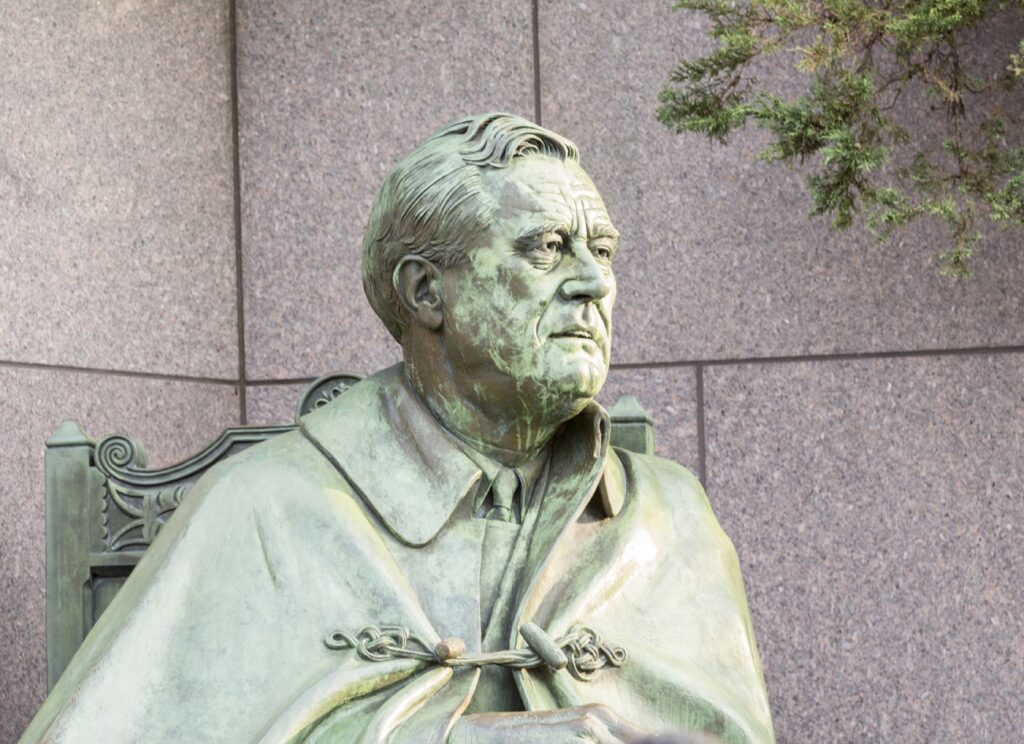Changing the opinions of others and bringing them on side with your plans and policies is key to success as a leader. On 4th March 1933, FD Roosevelt became president and led America through the Great Depression and WW2. From an America intent on isolationism, Roosevelt engineered support for British war efforts and a more active role on the international political stage.
Franklin Delano Roosevelt, or FDR, is the only American president to have been elected four times and is seen as one of the most popular presidents in US history.
But how did Roosevelt, when faced with a nation intent on keeping itself separate from the troubles of the rest of the globe as it tended to its own needs, manage to change opinions and engender support for breaking free of neutrality and supporting the Allies, whilst maintaining his popularity?
It appears to have been a Herculean task, but FDR’s leadership tactics, it would appear, were relatively simple:
Go slow and choose your moment
To go from isolationism to internationalism is akin to asking a member of your team to believe that right is wrong or that wrong is right, in other words a complete about turn in opinion. Roosevelt understood that such an enormous opinion change could not be achieved overnight, but rather over an extended period of time.
In 1937, two years before the beginning of WW2, FDR said: “We dedicated ourselves to the fulfilment of a vision- to speed the time when there would be for all the people that security and peace essential to the pursuit of happiness”.
Indeed, the US didn’t enter the war until after Pearl Harbour in 1941, but by then the foundations had been firmly laid.
As a leader, don’t expect that you can implement any significant attitude change without significant groundwork.
Aim for the transformational
Transformational leaders aim to influence the ethical, moral, intellectual and ideological principles of their followers to effect change.
In 1937 Roosevelt said: “We are beginning to abandon our tolerance of the abuse of power by those who betray for profit the elementary decencies of life”.
Indeed here, FDR is acknowledging the progress that followers have made which a leader can use as a technique to encourage whilst acknowledging further work required.
Furthermore, Roosevelt said: “The greatest change we have witnessed is the change in the moral climate of America…we have come from the days of stagnation and despair…to hold onto progress today is more difficult. Dulled conscience, irresponsibility and ruthless self-interest already reappear”.
When required attitude or opinion change is momentous, motivating followers regularly and urging them to not fall but strive to do even better is paramount.
Don’t expect that you can implement any significant attitude change without significant groundwork.
Monitor and adapt
Roosevelt was always keen to know whether his tactics were working through close monitoring of public opinion; it is said that FDR devoted more time to this than any of his predecessors and arguably his successors too. If you are not aware of the opinions’ of your followers to your ideas and proposals, you cannot know where your efforts should be concentrated.
This tactic allowed FDR to maintain a high approval rating from external polls during his leadership.
Be accessible
As a leader in a senior position it may not always be possible to be closely working alongside followers, as was the case for Roosevelt, but there is always a solution. Roosevelt’s ‘fireside chats’ made him accessible and real. Consider, what could be your equivalent to the fireside chat?
Turn adversaries into advocates
The King of turning a negative into a positive, Roosevelt was keen to disarm opponents by welcoming them, and the more high profile the better.
For FDR this meant making Wendell Welkie, who stood against him for his third term as president, into his personal ambassador to Winston Churchill. As a leader, look to see who the most visible and powerful antagonists to your vision are and focus efforts at changing their opinions, others will follow.
State the alternative
An about turn in opinion or attitude is undoubtedly arduous for followers, and whilst articulating a vision is important, so too is communicating the alternative.
In January 1945, around 8 months before the end of WW2, as spirits were flailing and resolve was weakening, Roosevelt said: “Everything we have and are is at stake”, calling the Axis powers: “The strongest and most violently aggressive powers that have ever threatened civilisation”.
Without the leadership of Roosevelt, his commitment to what he considered morally right through his support of Great Britain and the other Allies both before the US entry into the war and after, the result of WW2 may have been rather different.
Sadly, Roosevelt died on 12th April 1945 of a brain haemorrhage just months short of the end of the war, but he left behind a legacy that endures and leadership techniques that we can all learn from.
Changing the opinions of others and bringing them on side with your plans and policies is key to success as a leader. On 4th March 1933, FD Roosevelt became president and led America through the Great Depression and WW2. From an America intent on isolationism, Roosevelt engineered support for British war efforts and a more active role on the international political stage.
Franklin Delano Roosevelt, or FDR, is the only American president to have been elected four times and is seen as one of the most popular presidents in US history.
But how did Roosevelt, when faced with a nation intent on keeping itself separate from the troubles of the rest of the globe as it tended to its own needs, manage to change opinions and engender support for breaking free of neutrality and supporting the Allies, whilst maintaining his popularity?
It appears to have been a Herculean task, but FDR’s leadership tactics, it would appear, were relatively simple:
Go slow and choose your moment
To go from isolationism to internationalism is akin to asking a member of your team to believe that right is wrong or that wrong is right, in other words a complete about turn in opinion. Roosevelt understood that such an enormous opinion change could not be achieved overnight, but rather over an extended period of time.
In 1937, two years before the beginning of WW2, FDR said: “We dedicated ourselves to the fulfilment of a vision- to speed the time when there would be for all the people that security and peace essential to the pursuit of happiness”.
Indeed, the US didn’t enter the war until after Pearl Harbour in 1941, but by then the foundations had been firmly laid.
As a leader, don’t expect that you can implement any significant attitude change without significant groundwork.
Aim for the transformational
Transformational leaders aim to influence the ethical, moral, intellectual and ideological principles of their followers to effect change.
In 1937 Roosevelt said: “We are beginning to abandon our tolerance of the abuse of power by those who betray for profit the elementary decencies of life”.
Indeed here, FDR is acknowledging the progress that followers have made which a leader can use as a technique to encourage whilst acknowledging further work required.
Furthermore, Roosevelt said: “The greatest change we have witnessed is the change in the moral climate of America…we have come from the days of stagnation and despair…to hold onto progress today is more difficult. Dulled conscience, irresponsibility and ruthless self-interest already reappear”.
When required attitude or opinion change is momentous, motivating followers regularly and urging them to not fall but strive to do even better is paramount.
Don’t expect that you can implement any significant attitude change without significant groundwork.
Monitor and adapt
Roosevelt was always keen to know whether his tactics were working through close monitoring of public opinion; it is said that FDR devoted more time to this than any of his predecessors and arguably his successors too. If you are not aware of the opinions’ of your followers to your ideas and proposals, you cannot know where your efforts should be concentrated.
This tactic allowed FDR to maintain a high approval rating from external polls during his leadership.
Be accessible
As a leader in a senior position it may not always be possible to be closely working alongside followers, as was the case for Roosevelt, but there is always a solution. Roosevelt’s ‘fireside chats’ made him accessible and real. Consider, what could be your equivalent to the fireside chat?
Turn adversaries into advocates
The King of turning a negative into a positive, Roosevelt was keen to disarm opponents by welcoming them, and the more high profile the better.
For FDR this meant making Wendell Welkie, who stood against him for his third term as president, into his personal ambassador to Winston Churchill. As a leader, look to see who the most visible and powerful antagonists to your vision are and focus efforts at changing their opinions, others will follow.
State the alternative
An about turn in opinion or attitude is undoubtedly arduous for followers, and whilst articulating a vision is important, so too is communicating the alternative.
In January 1945, around 8 months before the end of WW2, as spirits were flailing and resolve was weakening, Roosevelt said: “Everything we have and are is at stake”, calling the Axis powers: “The strongest and most violently aggressive powers that have ever threatened civilisation”.
Without the leadership of Roosevelt, his commitment to what he considered morally right through his support of Great Britain and the other Allies both before the US entry into the war and after, the result of WW2 may have been rather different.
Sadly, Roosevelt died on 12th April 1945 of a brain haemorrhage just months short of the end of the war, but he left behind a legacy that endures and leadership techniques that we can all learn from.





